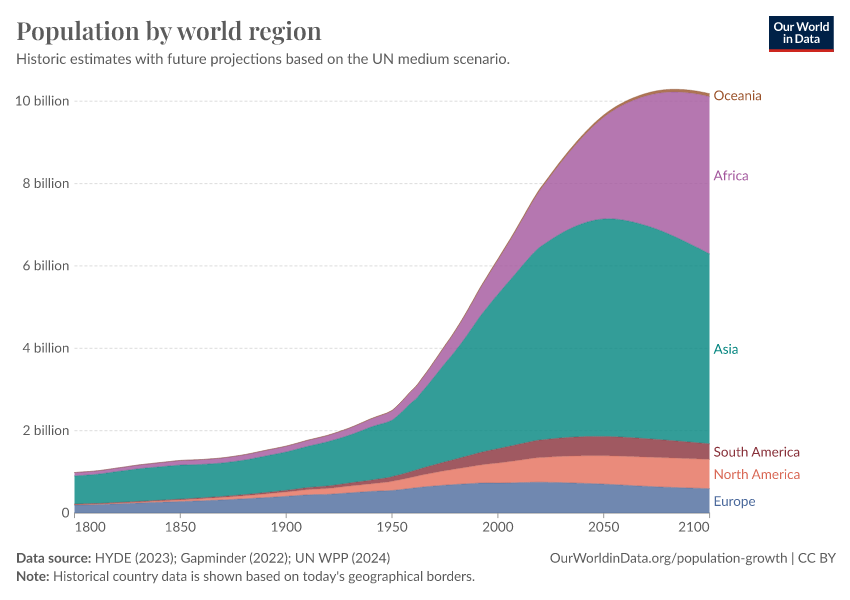More than 8 out of 10 people in the world will live in Asia or Africa by 2100
Most of the world’s population growth over the next century is expected to come from Africa.
The United Nations projects that world population growth will slow significantly over the course of the 21st century, reaching 10.4 billion in the 2080s before slowly falling. But how is this growth distributed across the world? How does the world look in 2100 compared to today?
In this chart we see the global population split by region. This shows historical data, but also projections to 2100 based on the UN's medium growth scenario.

The striking change between now and 2100 is the expected growth in the African population. In 2023, its population is around 1.4 billion; by 2100 it's projected to reach just under 4 billion.
Over the past 50 years Asia experienced rapid population growth. In 2023, its population is around 4.8 billion. By 2050 it's expected to rise to 5.3 billion, but then fall in the latter half of the century. You can read more about the driving force behind these demographic changes here. By 2100 Asia's population is projected to fall almost back to levels we see today.
You can use the 'relative' toggle in the chart to see each region's share of the world population. In 2023, Africa is home to around 18% of the global population; by 2100 this is projected to rise to 38%. Asia will see a significant fall from almost 60% today to around 45% in 2100.
By the end of the century, more than 8 out of every 10 people in the world will live in Asia or Africa.
North, Central and South America, and Oceania, are projected to also see a rise in population this century – but this growth will be much more modest relative to growth in Africa. Europe is the only region where population is expected to fall.
These changes will bring new opportunities and challenges. Extreme poverty, for example, is expected to become increasingly concentrated in Africa in the decades which follow. This will represent a major shift from the century before.
Cite this work
Our articles and data visualizations rely on work from many different people and organizations. When citing this article, please also cite the underlying data sources. This article can be cited as:
Hannah Ritchie (2019) - “More than 8 out of 10 people in the world will live in Asia or Africa by 2100” Published online at OurWorldinData.org. Retrieved from: 'https://archive.ourworldindata.org/20251125-173858/region-population-2100.html' [Online Resource] (archived on November 25, 2025).BibTeX citation
@article{owid-region-population-2100,
author = {Hannah Ritchie},
title = {More than 8 out of 10 people in the world will live in Asia or Africa by 2100},
journal = {Our World in Data},
year = {2019},
note = {https://archive.ourworldindata.org/20251125-173858/region-population-2100.html}
}Reuse this work freely
All visualizations, data, and code produced by Our World in Data are completely open access under the Creative Commons BY license. You have the permission to use, distribute, and reproduce these in any medium, provided the source and authors are credited.
The data produced by third parties and made available by Our World in Data is subject to the license terms from the original third-party authors. We will always indicate the original source of the data in our documentation, so you should always check the license of any such third-party data before use and redistribution.
All of our charts can be embedded in any site.